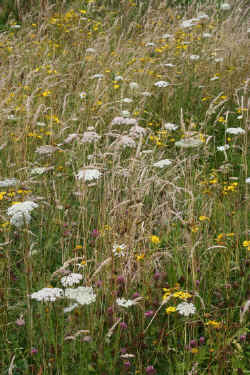| If purchasing this
seed mix, print this page and keep it as your reference.
Native Origin Irish Wildflower Seed Mixture: Range: Meadow Mixtures (Code MM) Supplied without grass, Grass seed can be added Product Name: Wild Flora for Clay and Gley (sticky top soil) Product Code: MM02 Description: This mixture will grow on any heavy soil, (usually moisture retentive) MM02 - Is a top selling timeless seed mixture suitable for many areas in Ireland, esp' Wexford or where the soil has a high silt content often derived from poorer sticky subsoil or where the top soil is shallow over heavy subsoil. MM02 is a medium to tall mix suited to any moisture retentive sticky soil. It will perform even if the clay dries out. This mixture will grow very well on old well worked clay soils or new gardens with builders clay compacted after the builders have finished. Ideal for nutrient improved acidic gley, clays and daub basic soils. On clay soils, after an initial cleaning of the seed bed, weeds and grasses may re-invade, wait a few weeks and clean up the weeds again.
Species
List: This mixtures contains 1% native grass seed harvested with The Yellow Rattle, 1% grass is so little you will hardly notice it, the grass acts as a host for Yellow Rattle.
MM02 will be at its best between July and September. The tall Meadow Buttercup will provide great spring colour to start the season Do not confuse Meadow Buttercup with Creeping Buttercup, which is not included, but may be present on many a clay soil. Cut the meadow just before the Creeping Buttercup flowers, if the problem gets worse over-sow the meadow with grasses to control infestation of creeping buttercup.
Mixture Specifications: This photograph is one day in the life of an ever changing meadow. this mixture has far more colour than is displayed
Product Warning: DBN recommends that this mixture is not for human or animal consumption.
Sowing
Specification:
Sowing Conditions: Clay soil will be difficult to sow and rake. roll, press or rake into surface to keep out of reach from birds. Sowing
Method: By hand is recommended, if using seed spreaders be careful to
insure the small varieties of seed do not drop to the bottom of the seed
spreader and get sown all in the one place. Can be Hydrasown.
Seed
Sowing Rates: 1.5 grams per metre.
Performance:
In the third year this meadow mixture will seem
to have less flora than the first and second year. Why?
When should this meadow be established and require one cut? A wildflower meadow should last many years, provided the wildflower species were correctly established, weeds were controlled and the meadow was cut and the cut material removed and occasional 'Gaps' are created. If not contact DBN. Persistence if unmanaged: Low
Tolerance of Cutting: High tolerance after second year. Specific Cutting Time: Wait 3 weeks until after the last flush of flowers fade away, after seeds set. Disposal of cut materials: Always remove the cuttings, wildflower meadow hay should be removed as soon as possible and not be heaped on site as it will grow mouldy (a health risk). Meadow cuttings can be spread as compost in sheet mulches around trees and shrubs or composted. Management: Control grasses and weeds until well established. Accept any normal non-invasive weeds in first year as they provide cover, once the sward is established, digging, spot spraying or weed wiping can be used to eliminate problem species. Control weeds, especially Creeping Buttercup, if Creeping Buttercup is present cut this meadow in May in year two. The third year is the critical year to maintain this meadow as scutch grass, creeping thistle, nettle and dock will try to dominate as the growing conditions are ideal for such unwanted species. Most species in this mixture are 'Browse' resistant.
A
General Description of Meadow Range:
Your purchase:
Contributes to DBN's work of creating crops
of Conservation Grade - Native Origin Wildflora. You help us to inform
and pay land-owners to manage native species and to assist DBN in
handing on our heritage for another generation.
|

